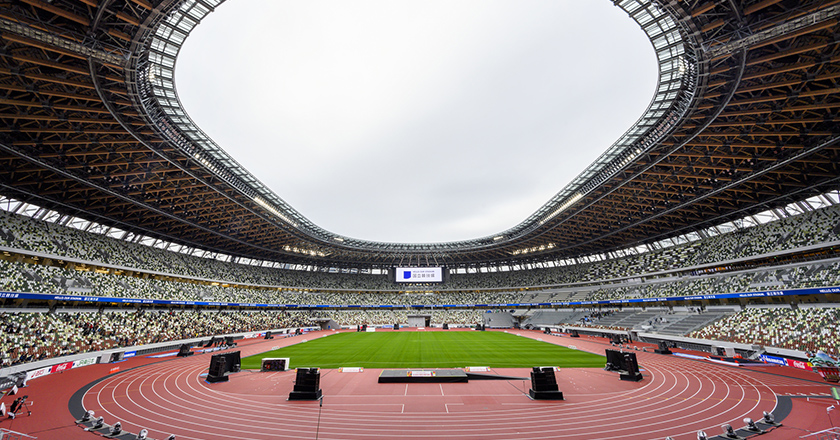Why do we bid to host the Olympic Games?
The Tokyo 2020 Olympic and Paralympic Games encountered many scandals from the beginning of the bidding process to the conclusion of the Games.
For some time after the successful bidding the protest movement was rather limited despite a spate of scandals. However, after the one-year postponement due to the pandemic, and as the number of infected people increased in Tokyo and nationwide, criticism from the public escalated.
In fact, according to opinion polls by different media right before the Games, the number of people who “disagree” with holding the Games (cancellation or re-postponement) largely exceeded that who “agree” with it.
Nevertheless, the Olympic Games were held under the declaration of a state of emergency, and the number of newly infected people reached a record high in Tokyo during the period, and stringency on the medical front became more serious.
After the Games finished, we may only recall the flourishing athletes. However, it does not at all mean that the criticism against the execution, financial status, pending challenges, etc. are resolved.
Olympic Games are events which cost a lot, and are also burdensome for the urban environment. They significantly impact the structure of the city and the lives of the people.
Everybody knows that with the bidding for the 1964 Tokyo Games, major urban development projects, including the construction of the Metropolitan Expressway, were carried out. Many of them were accepted as infrastructure improvements to support the rapid economic growth. So, what was done in the 2020 Games?
There were many existing sports facilities in Tokyo, but we all know that they were not the only ones that were used in the Games. The national stadium was rebuilt, and multiple new sports facilities were built in the bay area. The Olympic Village has become a private condominium.
What were they all for? Perhaps not many people can answer this, although a large amount of public money was spent on them.
I have been studying to clarify just that from the fiscal year 2016 to 2022 as a representative of a research group mainly consisting of geographers to clarify the actual status of the Olympic urban development and area development.
As a result, I can say that the development associated with the 2020 Tokyo Olympic Games did not have a consistent purpose or a goal, and consisted of mere economic stimulus measures or was just an event to alleviate the accumulating frustrations in society.
Urban regeneration and bidding to host the games
Originally, my main field of research on urban planning projects was France. When the landscape of a city changes, what kind of ideological background is behind it, and by what kind of process does it happen? I study these questions from the human geographical perspective.
Then, I had an opportunity to stay in London, the U.K. for a year in 2014, and during that time I visited the Queen Elizabeth Olympic Park. It is a public park cum multiple sports facility, utilizing the site of the former 2012 London Games venue.
First of all, I was surprised by its enormous size. Japan co-hosted a gigantic event called the FIFA World Cup with South Korea in 2002, but I keenly felt that hosting Olympic Games requires facilities on a completely different scale from that sports event.
This experience became the foundation of my research on the Olympics and urban planning. While it was decided in September 2013 that Tokyo would host the 2020 Games, and after that, Paris was chosen to host the 2024 Games, I advanced my research focusing on a comparison of these three cities.
We generally call international events like the Olympics and international expositions (EXPOs) mega-events. They are not only economically enormously costly events but also have nature of promoting various relevant policies such as infrastructure development. Hence, they are used to trigger a major transformation of a city.
In addition, when hosting is determined, the deadline for implementation is established. This time constraint will push forward the plans or policies that would be difficult to proceed if we left them up to the market. Therefore, people in charge of policies are motivated to bid for hosting events.
Moreover, events will extensively involve things that are associated with them, including things that are indirectly relevant at most. Every time a venue has been developed, residents have been displaced and people have lost their jobs in the area.
Considering these characteristics, when we look at urban development, what is common between London, Tokyo, and Paris is that they recreated the city in accordance with post-industrialization at the same time they carried out Olympic-related developments.
Since the 1970s, in Europe and the U.S., owing to companies moving their production bases, vast industrial districts remained without being used in urban areas and their surroundings. Tokyo, which relatively maintained its manufacturing industry until the 1980s, also reached its post-industrial era in the 1990s.
Then, the redevelopment which was required was, instead of being for continuity as a city, an arrangement of infrastructure (including office buildings and residences) which attracted global capital.
In London, for the 2012 Games, the former industrial area called East London was recreated as the Olympic venue. Most of the area was ranked in the top 10 of England’s most impoverished areas. However, it is difficult to imagine such a picture from the current Olympic Park. The former Olympic Village and temporary athletic facilities were turned into a new residential area for the middle classes, and almost no historical trace remains.
In Paris, a northern suburb has become a place for redevelopment. The Grand Paris policy is continued, which redevelops the surroundings of the Stade de France constructed for the 1998 FIFA World Cup as a main venue. That is also a former industrial area, and characterized by unemployment and poverty from post-industrialization.
In Tokyo as well, in the past, warehouses and public housings were concentrated in the bay area, where many competition facilities were built. However, it has become a redevelopment area with a sprawl of high-rise condos by the urban regeneration plan under cooperation between the public and private sector, which has existed since the latter half of the 1990s.
The three cities share the fact that many of these areas for redevelopment are located around 10km from the city center.
Negative legacy and environmental burden
On the other hand, the level of understanding and response regarding the development in Tokyo is different from London and Paris in many ways. Among all this, it should be stressed that we could not see the major goal of Tokyo urban development, and we could not tell what was intended to promote by the Olympic Games.
In the first place, the redevelopment of areas where impoverished class was concentrated by post-industrialization had an aspect of investment in the areas neglected until then. At least in London and Paris, they clearly indicated the purpose of development such as promoting tourism and cutting-edge technology, and the future direction of the city.
As for Tokyo, although we could not see its future vision as a mega-city, and it was unclear who gets the advantage, the fiscal burden kept growing by continually increased spending. There is nothing left except to evaluate that it was only carried out as an economic stimulation measure.
In fact, various sports facilities were built based on the public stance that they were needed for competition. However, there are almost no clear plans for what to do with them from now on.
Most of the permanent facilities that were newly built by the Games, such as the Tokyo Aquatics Centre, a venue for swimming competitions, and Sea Forest Waterway for boat competitions, etc., cannot make any profit and are in the red.
How to utilize the Japan National Stadium after the event, which was the most burdensome for the area including evictions of public housing and homeless people is also not yet decided. Concerning the deficit part of the maintenance cost, there is a policy to cover a maximum 10 billion yen per year from public funding.
By the way, the London Stadium, which was the main field of the London Games, has been utilized since not only as an international sports venue but also as a home ground for a professional football team and is gaining continuous income.
Even if tax income is used for the deficit, if it is along the path to a major goal, taxpayers may be satisfied. However, if the facilities are built and end on a patchwork basis, it deserves to be called negative legacy.
Nowadays, I have many opportunities to talk to French researchers who have expectations of the Paris Games. They often ask me, “In Japan, by what were the Olympics Games justified?”
When I answer, “In Japan, the public awareness of urban development is low, and they are also indifferent about the public funding spent for it,” they are very surprised.For example, there is a trend to reorganize and perpetuate temporary competition venues where competitions such as skateboarding were held. However, they were appalled, saying, “As long as you make it, if you do not make it properly in the first place, it is burdensome for the environment. If you rebuild it just because the athletes flourished, there will be more of a burden. Such handling is unthinkable in France.”
Some people think that the accomplishment of the Tokyo Games was that the athletes gained lots of medals. However, besides being able to tentatively alleviate the accumulating frustrations in society, did the city improve?
I think we need to remind ourselves again that the Tokyo Olympic Games were held in a way which was extremely out of touch with the global sense of urban development.
* The information contained herein is current as of October 2023.
* The contents of articles on Meiji.net are based on the personal ideas and opinions of the author and do not indicate the official opinion of Meiji University.
* I work to achieve SDGs related to the educational and research themes that I am currently engaged in.
Information noted in the articles and videos, such as positions and affiliations, are current at the time of production.


